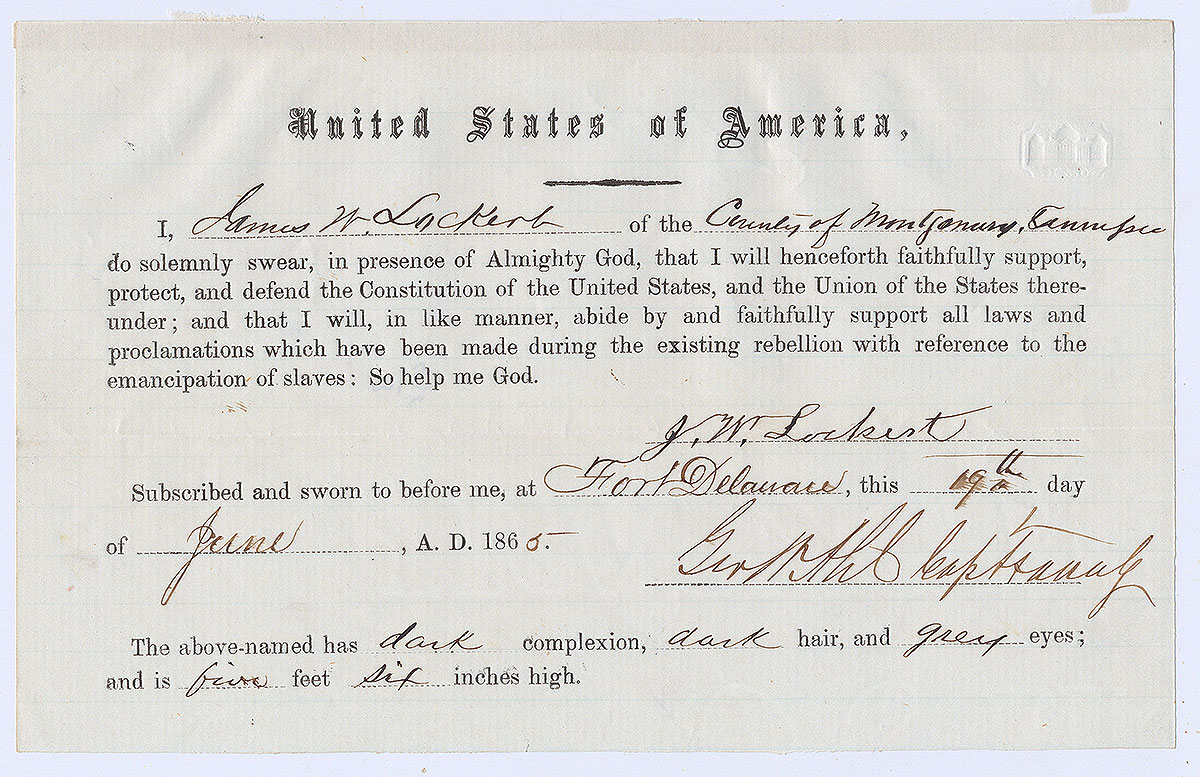site search
online catalog
OATH OF ALLEGIANCE OF LT. COL. JAMES W. LOCKERT, 14TH TENNESSEE, COMMANDING REGIMENT AT GETTYSBURG- WOUNDED AND TAKEN PRISONER IN PICKETT’S CHARGE NEAR THE ANGLE!

$950.00 SOLD
Quantity Available: None
Item Code: 557-260
James W. Lockert led the 14th Tennessee onto the field on July 1 Gettysburg 220 strong as part of Archer’s brigade in Heth’s division. In that first day’s fighting the brigade was outflanked and roughly handled by the Iron Brigade, and after just a day’s rest were sent into action again on July 3 with the division under Pettigrew and the brigade, now about 800 strong, under Col. B.D. Fry. They advanced on the immediate left of Garnett and Armistead and were the “brigade of direction” with Garnett’s left dressing on their right, linking Pickett and Pettigrew in the charge, and reached the federal line on the north side of the Angle. Lockert lost four color-bearers were shot down in the charge, the last just at the federal “works,” where they faced the 14th CT, 39th NY, the right of the 71st PA, and the guns of Arnold’s battery and then Weir’s, who replaced it. Lockert himself went down with a gunshot wound that fractured his right thigh and was captured. Of the 220 who began the battle, they lost 127- 15 killed, 37 wounded, and 75 captured, 57.7%. Lockert was hospitalized and incarcerated for almost two years. It was not until June 19, 1865, that he signed this oath of allegiance and was released on June 21. He was apparently something of an “unreconstructed rebel,” returning home to his wife and four sons, fathering a fifth who was born in 1867 and christened “Rebel Lee Lochert.”
Born in Tennessee in 1828, Lockert married in the early 1850s and at the beginning of the war was a blacksmith in Montgomery County, using as a Clarksville as post office address. He enlisted 5/27/1861 in company that became Company K of the 14th Tennessee, organizing near Clarksville for Confederate service, and was elected Captain by the company, whether he had any prewar militia experience is unknown. The regiment organized in May and early June 1861, and mustered in with 11 companies. In September they took part in Lee’s unsuccessful Cheat Mountain Campaign in western Virginia and later in the year marched to Winchester, joining Jackson’s forces in the Valley, taking part in the Romney Campaign in January 1862, which temporarily cleared Union forces out of the lower Shenandoah.
Afterward they moved to the Peninsula where they took part in the early fighting around West Point, and then at Seven Pines (Fair Oaks,) Mechanicsville and Gaines Mill, losing 84 men in the latter engagements. They lost another 33 men in the fighting at Cedar Mountain on August 9 including the Lieutenant Colonel, mortally wounded, resulting in the promotion of the regiment’s Major to his position and Lockert’s promotion from Captain to Major on August 15. At Second Manassas they lost 49 more men, included the Colonel mortally wounded, and Lockert’s promotion once again, this time to Lieutenant Colonel, officially on April 2, 1863, but with rank from Sept. 2, 1862.
Less than two weeks later they took part in the siege of Harpers Ferry and, shortly after, Antietam, where the new Colonel, McComb, was seriously wounded and Lockert took command of the regiment into October. In December they fought again at Fredericksburg, losing 59 men, and in May they were at Chancellorsville losing 35 more, including McComb with another wound, putting Lockert once more in command, leading the regiment in the Gettysburg Campaign. In looking at his service records we note only one point he was absent – for a 30 day sick-leave in late May 1863, putting hm with the regiment in all their engagements through Gettysburg as captain or field officer.
He was hospitalized at Camp Letterman in Gettysburg until September when he was sent to a general hospital, apparently in Baltimore, and then later transferred to Johnson’s Island at Sandusky, Ohio. In March 1865 he was sent to Point Lookout, MD, for exchange, but was bounced back and forth between there and Fort Delaware as the war ended. A secondary source suggests this was from a refusal to sign the oath, but more likely was from the fast-moving battlefield events of March and April, though the late June date of the oath is suggestive. It is perhaps significant when he signed the oath and was “released by order President” (in the words of an annotation in his file,) the President was fellow Tennessean Andrew Johnson.
This is in excellent condition with no folds or tears, boldly printed and filled out by hand in strong, brown ink. [jp] [ph:L]
~~~~~~~~~~~~~~~~~~~~~~~~~~~~~~~~~~~
THIS ITEM, AS WITH ALL OTHER ITEMS AVAILABLE ON OUR WEB SITE,
MAY BE PURCHASED THROUGH OUR LAYAWAY PROGRAM.
CLICK HERE FOR OUR POLICIES AND TERMS.
THANK YOU!
Inquire About OATH OF ALLEGIANCE OF LT. COL. JAMES W. LOCKERT, 14TH TENNESSEE, COMMANDING REGIMENT AT GETTYSBURG- WOUNDED AND TAKEN PRISONER IN PICKETT’S CHARGE NEAR THE ANGLE!
For inquiries, please email us at [email protected]
Most Popular
Historical Firearms Stolen From The National Civil War Museum In Harrisburg, Pa »
Theft From Gravesite Of Gen. John Reynolds »
Selection Of Unframed Prints By Don Troiani »
Fine Condition Brass Infantry Bugle Insignia »
British Imported, Confederate Used Bayonet »
Scarce New Model 1865 Sharps Still In Percussion Near Factory New »
featured item
WELL-WORN CIVIL WAR BROGANS
Officially known as the M1851 Jefferson Bootee, the simple but rugged “brogan” was the standard issue shoe for both US and CS forces during the Civil War. They have a medium rise upper with four eyelets for laces, a square toe, and pegged sole.… (1268-019). Learn More »



